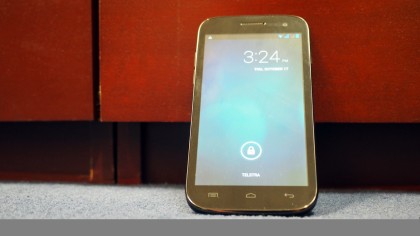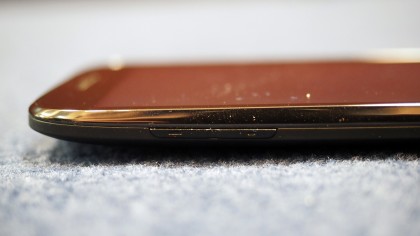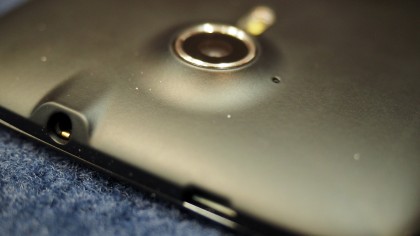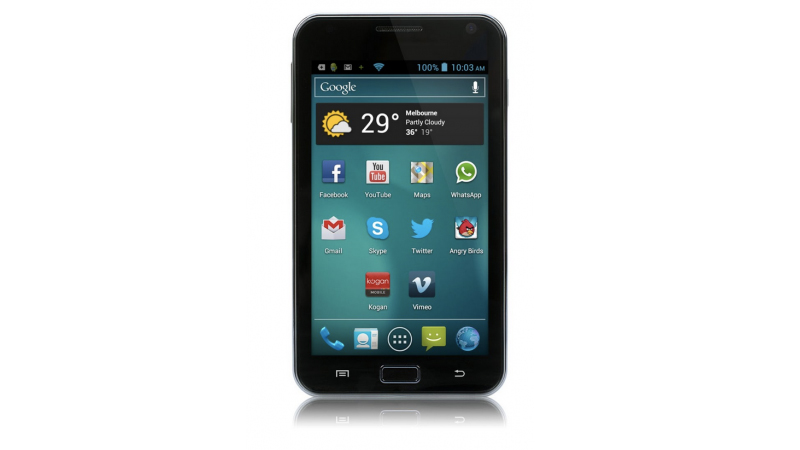Early Verdict
This phone punches above its weight. For under 200 bucks, it's impossible to argue the value for money case. But there are conditions: there's no 4G, and the 3G will work nicely on Telstra's 3G bands, but not Optus' 900MHz spectrum. The camera also has a pretty large question mark over the top of it.
Pros
- +
Cheap
- +
Great specs
- +
Decent design
Cons
- -
Only 4GB on board storage
- -
Average camera
Why you can trust TechRadar
No matter which way you look at it, AU$199 (£149, US$189) for a quad-core smartphone is a tough proposition to argue with.
While the likes of the Samsung Galaxy S4, HTC One and Sony Xperia Z1 get all the headlines, Aussie company Kogan has tried to trump them all with the new AU$199 (£149, US$189)quad-core Agora smartphone.
An update to the previous Agora 5-inch dual-core smartphone, the newer, HD version doubles the number of processing cores to four, adds 720p resolution to the now IPS 5-inch display and bundles in 1GB RAM and 4GB of on board storage, with a MicroSD card slot to expand that when it runs out.
Like the previous version, Kogan has squeezed in a second SIM card slot, which allows users to make calls over 2G networks. We say squeezed because both slots are actually for full-sized SIMs, which are almost as rare as white rhinos these days.

Inside, the 2,000mAh battery keeps the Android 4.2 Jelly Bean phone running while you're making and taking calls.
The camera on the back has been upgraded to 8MP, while the front facing snapper now boasts 2MP, although as we know, not all phone cameras are created equal.
Overall, it's a pretty impressive spec upgrade to the dual-core model from the start of the year.
Sign up for breaking news, reviews, opinion, top tech deals, and more.

The appearance
Unboxing the Agora 5.0-inch HD, it's amazing to think how for Kogan has come in terms of design since its original Agora Android prototype back in 2009.
The front of the phone looks fairly standard in today's sea of large Android devices. The 5-inch screen is surrounded by a narrow black bezel on the sides. Above, the speaker and front-facing camera rest while Android's standard three soft buttons can be found below.
The left side has the volume rocker, the right side has the power button. Up top, a 3.5mm headphone jack and MicroUSB slot rest, awaiting cable insertion.

The back of the device is a matte black cover, that seems to blend perfectly into the phone's body. It's not initially apparent how to open the back cover, although once you do manage to work it out (by pulling around the MicroUSB jack), it becomes evident that the back cover isn't as robust as it appears.
Still, the cover is comfortable to hold and offers a decent grip, which is something lacking in many modern phones.
Pop open the bonnet, and you're confronted with those two full-size SIM card slots, with a MicroSD slot wedged between them. Below these, the 2,000mAh battery resides.

While it's possible to slip your SIM cards into the phone without removing the battery, taking them out again will require the power to be removed. It's a small thing, but can be slightly frustrating, especially if you're using an adapter to bring your Nano or Micro SIM card up to full-size to fit the slots and there's an issue.
The phone itself is a little bit chunkier than many phones, although it's nowhere near a deal breaker. The tapered edges of the back actually help mitigate any real issues with holding the device in the hand

Initial testing
Our ongoing tests will offer a more definite answer, but initial results show that the quad-core processor inside the Agora does a pretty good job at keeping things snappy. There wasn't any real lag or delay, with the phone switching between apps nice and quickly.
The 8MP, meanwhile, still seems to struggle a bit in terms of clarity and definition. We haven't been able to put it through its paces fully yet, but the few pics we did take in our initial play with the device all seemed a bit washed out and grainy.

The screen itself shows the biggest improvement over the previous generation. Bright, vibrant and clear, the 1280 x 720 pixel resolution is a far cry from the 800 x 600 of the Agora dual core model. Viewing angles are respectable, although not fantastic, and even squinting it's tough to make out the individual pixels on display.
Early verdict
No question about it, this phone punches above its weight. For under 200 bucks, it's impossible to argue the value for money case.
There are some conditions though. There's no 4G, and the 3G will work nicely on Telstra's 3G bands, but not Optus' 900MHz spectrum. The camera also has a pretty large question mark over the top of it.

Given that the Nexus 4 will set you back AU$249, with double the storage but half the SIM card slots, there's an argument that it's not the best value for money in the market, although it does come close.
We'll be interested to see how it really performs as we fully test it, but first impressions tell us this is a great device for those looking for a budget handset.
What is a hands on review?
Hands on reviews' are a journalist's first impressions of a piece of kit based on spending some time with it. It may be just a few moments, or a few hours. The important thing is we have been able to play with it ourselves and can give you some sense of what it's like to use, even if it's only an embryonic view. For more information, see TechRadar's Reviews Guarantee.
